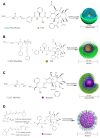Polymeric Micelles for Breast Cancer Therapy: Recent Updates, Clinical Translation and Regulatory Considerations
- PMID: 36145608
- PMCID: PMC9501124
- DOI: 10.3390/pharmaceutics14091860
Polymeric Micelles for Breast Cancer Therapy: Recent Updates, Clinical Translation and Regulatory Considerations
Abstract
With the growing burden of cancer, parallel advancements in anticancer nanotechnological solutions have been witnessed. Among the different types of cancers, breast cancer accounts for approximately 25% and leads to 15% of deaths. Nanomedicine and its allied fields of material science have revolutionized the science of medicine in the 21st century. Novel treatments have paved the way for improved drug delivery systems that have better efficacy and reduced adverse effects. A variety of nanoformulations using lipids, polymers, inorganic, and peptide-based nanomedicines with various functionalities are being synthesized. Thus, elaborate knowledge of these intelligent nanomedicines for highly promising drug delivery systems is of prime importance. Polymeric micelles (PMs) are generally easy to prepare with good solubilization properties; hence, they appear to be an attractive alternative over the other nanosystems. Although an overall perspective of PM systems has been presented in recent reviews, a brief discussion has been provided on PMs for breast cancer. This review provides a discussion of the state-of-the-art PMs together with the most recent advances in this field. Furthermore, special emphasis is placed on regulatory guidelines, clinical translation potential, and future aspects of the use of PMs in breast cancer treatment. The recent developments in micelle formulations look promising, with regulatory guidelines that are now more clearly defined; hence, we anticipate early clinical translation in the near future.
Keywords: bioavailability; breast cancer; clinical translation; drug delivery; polymeric micelles; regulatory affairs.
Conflict of interest statement
The authors declare no conflict of interest. The company had no role in the design of the study; in the collection, analyses, or interpretation of data; in the writing of the manuscript, or in the decision to publish the results.
Figures










Similar articles
-
Polymeric Micellar Systems-A Special Emphasis on "Smart" Drug Delivery.Pharmaceutics. 2023 Mar 17;15(3):976. doi: 10.3390/pharmaceutics15030976. Pharmaceutics. 2023. PMID: 36986837 Free PMC article. Review.
-
The Clinical Translation of Organic Nanomaterials for Cancer Therapy: A Focus on Polymeric Nanoparticles, Micelles, Liposomes and Exosomes.Curr Med Chem. 2018;25(34):4224-4268. doi: 10.2174/0929867324666170830113755. Curr Med Chem. 2018. PMID: 28875844 Review.
-
Polymeric micelles and cancer therapy: an ingenious multimodal tumor-targeted drug delivery system.Drug Deliv Transl Res. 2023 Jan;13(1):135-163. doi: 10.1007/s13346-022-01197-4. Epub 2022 Jun 21. Drug Deliv Transl Res. 2023. PMID: 35727533 Review.
-
Intelligent polymeric micelles for multidrug co-delivery and cancer therapy.Artif Cells Nanomed Biotechnol. 2019 Dec;47(1):1476-1487. doi: 10.1080/21691401.2019.1601104. Artif Cells Nanomed Biotechnol. 2019. PMID: 31070063 Review.
-
Polymeric mixed micelles as nanomedicines: Achievements and perspectives.Eur J Pharm Biopharm. 2017 Apr;113:211-228. doi: 10.1016/j.ejpb.2016.12.019. Epub 2017 Jan 11. Eur J Pharm Biopharm. 2017. PMID: 28087380 Review.
Cited by
-
A review of FDA approved drugs and their formulations for the treatment of breast cancer.Front Pharmacol. 2023 Jul 28;14:1184472. doi: 10.3389/fphar.2023.1184472. eCollection 2023. Front Pharmacol. 2023. PMID: 37576816 Free PMC article. Review.
-
Chitosan-Based Nano-Smart Drug Delivery System in Breast Cancer Therapy.Pharmaceutics. 2023 Mar 8;15(3):879. doi: 10.3390/pharmaceutics15030879. Pharmaceutics. 2023. PMID: 36986740 Free PMC article. Review.
-
Polymeric Micelle-Based Nanogels as Emerging Drug Delivery Systems in Breast Cancer Treatment: Promises and Challenges.Curr Drug Targets. 2024;25(10):649-669. doi: 10.2174/0113894501294136240610061328. Curr Drug Targets. 2024. PMID: 38919076 Review.
-
Pharmacokinetics and Anti-Diabetic Studies of Gliclazide Nanosuspension.Pharmaceutics. 2022 Sep 14;14(9):1947. doi: 10.3390/pharmaceutics14091947. Pharmaceutics. 2022. PMID: 36145695 Free PMC article.
-
Design and Biocompatibility of Biodegradable Poly(octamethylene suberate) Nanoparticles to Treat Skin Diseases.Pharmaceutics. 2024 Jun 3;16(6):753. doi: 10.3390/pharmaceutics16060753. Pharmaceutics. 2024. PMID: 38931876 Free PMC article.
References
-
- Ring A., Harper-Wynne C., Smith I., Breast Cancer Cancer Chemotherapy and Biological Response Modifiers. 2005. [(accessed on 10 August 2022)]. Available online: https://www.who.int/news-room/fact-sheets/detail/breast-cancer. - PubMed
Publication types
LinkOut - more resources
Full Text Sources

